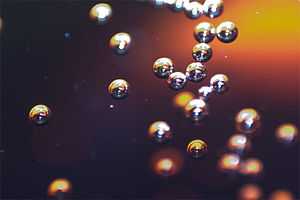Carbonation

Carbonation or fizz is the process of dissolving carbon dioxide in a liquid. The process usually involves carbon dioxide under high pressure. When the pressure is reduced, the carbon dioxide is released from the solution as small bubbles, which causes the solution to become effervescent, or fizzy. An example of carbonation is the dissolving of carbon dioxide in water, resulting in carbonated water.
Chemistry
Carbon dioxide is weakly soluble in water, therefore it separates into a gas when the pressure is released.
Biochemistry

Carbonation also describes the incorporation of carbon dioxide into chemical compounds. Our carbon-based life originates from a carbonation reaction that is most often catalysed by the enzyme RuBisCO. So important is this carbonation process that a significant fraction of leaf mass consists of this carbonating enzyme.[1]

See also
- Diet Coke and Mentos eruption
- Fizz keeper
- Industrial gas
- Nitrogenation
- Nucleation
- Pop rocks
References
External links
| Look up effervescence in Wiktionary, the free dictionary. |
| Look up carbonation in Wiktionary, the free dictionary. |
- Carbonation and Acidity
- Dissolution of Marble in Hydrochloric Acid Demonstration (instruction and video)
- Robert O'Leary. "ATR Infrared Spectroscopy method for measuring CO2 concentration in Beer" (PDF). Describes in detail the theory and practice of measuring dissolved CO2 content in soft drinks and beer.